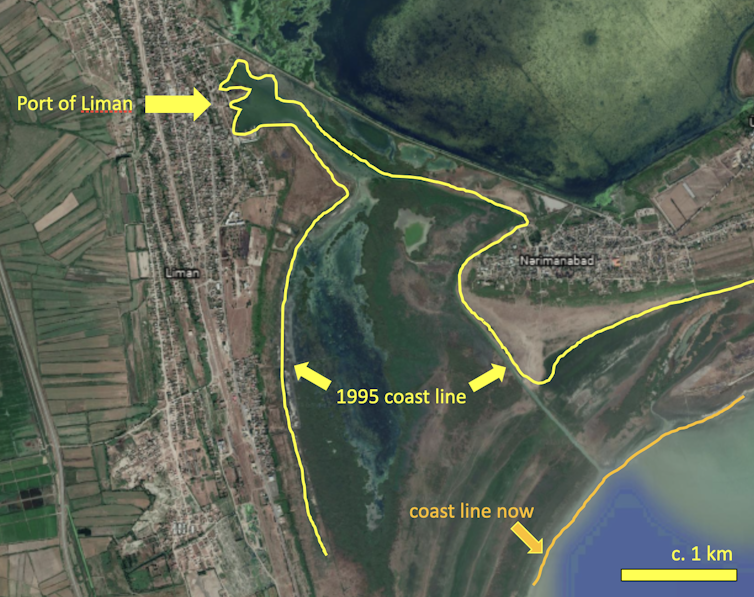
Frank Wesselingh, Utrecht University and Matteo Lattuada, University of Giessen
Imagine you are on the coast, looking out to sea. In front of you lies 100 meters of barren sand that looks like a beach at low tide with gentle waves beyond. And yet there are no tides.
This is what we found when we visited the small harbour of Liman, on the Caspian Sea coast of Azerbaijan. The Caspian is actually a lake, the largest in the world, and it is experiencing a devastating decline in its water level that is about to accelerate. By the end of the century, the Caspian Sea will be nine meters to 18 meters lower. That’s a depth considerably taller than most houses.
It means the lake will lose at least 25% of its former size, uncovering 93,000 sq km of dry land. If that new land were a country, it would be the size of Portugal.
 The Caspian borders five countries and is about the size of Germany or Japan. Rainer Lesniewski / shutterstock
The Caspian borders five countries and is about the size of Germany or Japan. Rainer Lesniewski / shutterstockAs we found in our new research, the crisis may well result in ecocide as devastating as the one in the Aral Sea, a few hundred kilometers to the east. The Caspian’s surface is already dropping by 7cm every year, a trend likely to increase. In five years it might be about 40cm lower than today and in ten years almost one meter lower. Maritime countries worldwide are coming to terms with one meter or so of sea-level rise by the end of the century. The Caspian Sea faces a drop of that size – except it will happen within a decade.
Climate change is the culprit. The Caspian Sea waters are isolated, its surface is already around 28 meters below the global oceans. Its level is the product of how much water is flowing in from rivers, mostly the mighty Volga to the north, how much it rains, and how much evaporates away.
At the end of the century, the Volga and other northern rivers will still be there. However, a projected temperature rise of about 3℃ to 4℃ in the region will drive evaporation through the roof.
Future misery despite past crises
The Caspian Sea has a history of violent rises and falls. In Derbent, on the Caucasus coast of Russia, submerged ancient city walls testify to how low the sea was in medieval times. Around 10,000 years ago the Caspian was about 100 meters lower. A few thousand years before that it was about 50 meters higher than today and even overspilled into the Black Sea.

Yet people who lived beside the sea were able to overcome the swings. No human infrastructure was around to be destroyed and many animal species simply moved up and down with the sea levels, as they had done over the past 2 million years or so. But this time is different. The fall will affect the Caspian’s unique and already stressed animal and plant life, along with human societies along the coasts.
In some areas, the coastline is about to retract hundreds of meters a year or more. Can you imagine building new piers and harbours that fast? By the time they are ready, the sea will have moved kilometers or tens of kilometers further away. Coastal promenades will soon be landlocked. The beaches of today will be the sand ridges stranded in barren plains of tomorrow.
The drop will also affect lowland rivers and deltas around the Caspian Sea. Once-fertile plains will become too dry for watermelon and rice farming to continue.
Unique Caspian life in peril
The town of Ramsar, on the Iranian coast, gave its name to a global wetland convention. But as the sea recedes, the town is becoming landlocked and the surrounding wetlands will be gone within decades.
 Officially listed as endangered, Caspian seal numbers have declined more than 90% over the past century. tristan tan / shutterstock
Officially listed as endangered, Caspian seal numbers have declined more than 90% over the past century. tristan tan / shutterstockThe shallower “shelves” of the northern and eastern Caspian are major food supplies for fish and birds, yet the entire northern and eastern shelves will transform into dry barren lands. This will devastate fish species, the Caspian seal, and the richness of mollusks and crustaceans species unique to the sea. These Caspian inhabitants have already suffered badly in the past century from pollution, poaching, and invasive species. About 99% of Caspian seal pups are raised on the winter ice of the North Caspian. Yet both the winter ice and indeed the whole north Caspian will disappear.
Remaining biodiversity hotspots in depths between 50 meters and 150 meters will be affected as rivers dump nutrients into the deeper central basins combined with rising temperatures. This will decrease oxygen levels and developing ecological dead zones could affect the remaining refuges of Caspian species. Genuine ecocide is around the corner.
 The Caspian coastline is already receding. Frank Wesselingh / Google Earth, Author provided
The Caspian coastline is already receding. Frank Wesselingh / Google Earth, Author providedThe situation cries for action, but possibilities are limited. Rising global CO₂ levels, the main driver of climate conditions causing the Caspian crisis, can only be dealt with with global agreements. In Soviet times, large-scale water diversions from Siberian rivers were proposed to deal with the shrinking Aral Sea to the east. But such large works – in the case of the Caspian Sea, a canal from the Black Sea might be considered – come with huge ecological and geopolitical risks.
Yet action is necessary to safeguard the Caspian Sea’s unique plants and animals and the livelihood of the people who live around it. The stranded small harbour in Liman is further from the sea every year. If no action is taken, it will be left alone in more than one way.![]()
Frank Wesselingh, Senior Researcher, Naturalis Biodiversity Center, Utrecht University and Matteo Lattuada, PhD Candidate, Department of Animal Ecology & Systematics, University of Giessen
This article is republished from The Conversation under a Creative Commons license. Read the original article.




22 Comments
Pingback: หวยไทย
Pingback: bonanza178
Pingback: coffee shop ambience
Pingback: bass japanese
Pingback: ประกันภัยโดรน
Pingback: cactus labs
Pingback: ltobet
Pingback: เว็บแทงมวย ไม่มีขั้นต่ำ ฝากง่ายถอนเร็วต้องเลือก Lsm99live
Pingback: ấu dâm
Pingback: ibc-ibcthai
Pingback: pgroyalbet
Pingback: the cali company disposable vapes
Pingback: putto33
Pingback: lost mary dr cherry
Pingback: ไก่ตัน
Pingback: โคมไฟ
Pingback: dtr car detailing
Pingback: Profinet Cable
Pingback: หวยหุ้นฮั่งเส็ง ทำกำไรกันได้ทุกวัน
Pingback: genie168
Pingback: ติดตั้ง ais fiber
Pingback: highbay